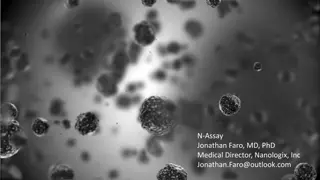Molecular Investigation of Zoonotic Pathogens in Rodents of Iran
This presentation explores the molecular investigation of zoonotic pathogens such as Coxiella burnetii, Bartonella, Rickettsia, Ehrlichia, Brucella, and Borrelia in rodents of Iran. It discusses the background of zoonotic disease pathogens, disease reservoirs, characteristics of Coxiella burnetii, vectors, and common human exposure routes.
Download Presentation

Please find below an Image/Link to download the presentation.
The content on the website is provided AS IS for your information and personal use only. It may not be sold, licensed, or shared on other websites without obtaining consent from the author. Download presentation by click this link. If you encounter any issues during the download, it is possible that the publisher has removed the file from their server.
E N D
Presentation Transcript
Molecular investigation of Coxiella burnetii, Bartonella, Rickettsia, Ehrlichia, Brucella and borrelia in Rodents of Iran Presented by: Niloofar Rezaie PhD. Student of Medical Microbiology Pasteur Institute of Iran 3
BACKGROUND Zoonotic disease pathogens shared with wild or domestic animals (responsible for 60% of human infectious diseases) . endemic in human populations enzootic in animal populations Vectors: Mosquitoes ticks flies fleas lice 4
BACKGROUND Zoonotic Disease reservoirs: Bats Pigs Sheep Swine Rabbits Rodents Cows Dogs Mammals . 5
: Coxiella burnetti Classically a strict intracellular Gram-negative bacterium Infects a wide range of animals, from arthropods to humans. The genetic determinants of virulence are now better known, thanks to the achievement of determining The clinical presentation of C. burnetii infection depends on 1-both the virulence of the infecting C. burnetii strain 2- specific risks factors in the infected patient. 6
Vectors and reserviors Domesticated ruminants, primarily cattle, sheep, and goats. Cats and dogs. Wildlife Ticks among animals but rarely in transmission to humans. 7
BACTERIA EXCRETED IN: Infected animals Feces Urine Milk Infected animals shed C. burnetii into the environment in milk, colostrum, urine, vaginal discharges and especially in birth products . High numbers of organisms exist in the amniotic fluids and placenta during birthing (e.g., 109bacteria/g placenta) . 8
Coxiella burnetti The ability to withstand harsh environmental conditions Is considered as a biological terrorist agent. C. burnetii survives in arthropod hosts, such as ticks. Q fever is mostly asymptomatic in livestock and animals, except in some cases, where causes abortion, stillbirth, endometritis or infertility. 9
COMMON HUMAN EXPOSURE ROUTES Inhalation of aerosols or contaminated dusts: A single inhaled organism may produce clinical illness. Bacteria shed in milk, urine, and feces of infected animals. High numbers of organisms in the amniotic fluids and placenta during birthing (e.g., 109 bacteria/g placenta) Contact with contaminated wool or other fomites. Ingestion of unpasteurized contaminated dairy products Sexual transmission Blood transfusion 10
Q Fever Clinical manifestations of Q fever in humans includes Major clinical presentations of these patients fever headache coughing, atypical pneumonia, hepatitis, myalgia, arthralgia, cardiac involvement, skin rash neurologic signs, Acute, Chronic Fatigue syndrome <60% of infected patients may be asymptomatic 11
Coxiella burnetti epidemoplogy in Iran In Iran, the first clinical cases of acute Q fever were reported in 1952. From 1970 to 1976, 133 patients with acute Q fever were reported from different parts of Iran. After 1976, Q fever was ignored in Iran and no cases were reported In 2009, Coxiella burnetii antibodies were reported in febrile patients in Kerman province (southeastern Iran), and research was resumed for Q fever. According to recent studies, Q fever is an endemic disease in Iran and this disease should be considered among animal and human populations 12
Bartonella Bartonella is a vector-borne bacterium various domestic and wild mammals. widespread among small mammals and may threaten human health . Bartonella spp. are gram-negative, slow-growing Intracellular pleomorphic bacillus Includes at least 35 species and three subspecies. Numerous animals are considered hosts and reservoirs for this disease primarily transmitted through flea and lice feces, sandflies, and possibly tick bites These bacteria cause chronic infections by infecting: 1- red blood cells 2-attacking endothelial cells, 3- CD34+progenitor cells 4- host dendritic cells . 13
Bartonella disease Bartonella infects humans and a wide variety of animal species. Bartonella spp. cause a variety of diseases in humans, including 1- cat-scratch disease (Bartonella henselae), 2- Carrion s disease (CD) (Bartonella bacilliformis), 3- trench fever (Bartonella quintana), 4- endocarditis (B. quintana and B. henselae), 5- bacillary angiomatosis (B. quintana and B. henselae), 6- hepatic peliosis (B. henselae and B. quintana ) 14
Rickettsia Rickettsioses: zoonotic infections and obligate intracellular bacteria. Rickettsiaceae Family: Rickettsia and Orientia. The lifecycle: Small mammals: as reservoirs or host. Arthropods: ticks, fleas, lice, and mites (as vectors). Rickettsial disease classification: Typhus group, Spotted Fever Group, Scrub Typhus. 15
Rickettsia Spotted fever group (SFG) is subdivided into two distinct subgroups: 1-Rocky Mountain Spotted Fever (RMSF) 2- Mediterranean Spotted Fever (MSF) 16
Rickettsia In humans, the symptoms of this disease are nonspecific are not diagnosed in time; Early symptoms include fever, chills, headache, and myalgia, and additional symptoms such as nausea, vomiting, and diarrhea can be seen in the subsequent steps. In untreated patients, mortality rates ranged from 5% to 25% . 17
Ehrlichia Anaplasmataceae family Small bacteria (0.4 microns) and obligate intracellular Gram-negative bacteria They paint poorly in gram , but they paint well with Giemsa and gimenez. Contamination of circulating leukocytes and proliferation within phagocytic vacuoles.. Carrier: Tick , except for neoRickettsia sennetsu (formerly Ehrlichia sennetsu) by eating infected fish Reservoir: animals (Dogs, Deer, Mice) Intracellular growth protects bacteria against the immune system. 18
Ehrlichia E. ruminantium is an important veterinary pathogen that causes an acute infection known as heartwater in domestic ruminants, mainly reported in sub-Saharan Africa . In a study in southeastern Iran, E. ewingii DNA was detected in ticks collected from camels . E.chaffeensis and E. ewingii are recognized as zoonotic pathogens that cause significant disease in the animal host. Ehrlichia chaffeensis is a causative agent of human monocytotropic ehrlichiosis, infection with E. ewingii leads to an undiagnosed clinical disease in immunocompromised patients . 19
Borrelia Relapsing fever Lyme disease B. burgdorferi Borrelia recurrentis, Borrelia hermsii Borrelia turicatae Borrelia parkeri. Relapsing fever caused by soft ticks is endemic in many regions of Iran. Rodents, are Borrelia reservoirs that transmit this bacteria from animals to humans. Ornithodoros is the common species of soft ticks in Iran. Borrelia persica, is the cause of relapsing fever in Iran. B. afzelii B. garinii in North America, Europe, and Asia, was followed by recognition that these organisms not only were genetically distinct from the RF group of species, but they also differed in several biological features in their vectors and reservoirs. transmitted by hard ticks of the instead of soft ticks, did not manifest transovarial transmission, generally achieved higher burdens in the skin than in the blood 20
Brucella Brucella is an intracellular and gram-negative agent that can lead to chronic damage in large breasts and humans. Brucellosis is known as one of the common agents between humans and animals around the world, which is mainly transmitted to humans as a result of consumption of unpasteurized dairy products or contact with animal contamination. The different species of Brucella that infect livestock and their primary hosts include B. melitensis (sheep and goats), B. abortus (cattle), B. suis (pigs), and B. ovis (sheep). It should also be noted that brucellosis reduces the productivity of livestock through the occurrence of abortions, reduced fertility and reduced milk production in infected animals and ultimately leads to an increase in economic attention. 21
Brucella BRUCELLA B. caniscanis as a common threat between humans and animals, it is less important and in most cases it leads to infection in humans Brucellosis is an uncontrolled public health concern in some areas such as Northeast Africa the Middle East and parts of America and Asia. Iran is also considered as an endemic region for this disease. 22
AIM OF STUDY The aim of this study is to investigate the molecular prevalence of Coxiella burnetii, Bartonella, Rickettsia, Brucella and Ehrlichia species in rodent samples in Iran. 23
SAMPLE COLLECTION In the present study, 618 spleen samples, were selected from the Biobank of Emerging and Reemerging Infectious Diseases of the Pasteur Institute of Iran which were collected from rodents in different parts of Iran (Tehran, Hamadan, Qazvin, West Azerbaijan, East Azerbaijan, Lorestan, Kurdistan, Hormozgan, Gilan, and Golestan) during 2015-2019 by maintaining the geographical distribution and diversity of rodent species. 25
Collection area Rodent distribution map and the number of samples collected from selected provinces in Iran 26
Prevalence of rodents in different provinces Province West Azerbaija n (%) East Total Genus Species Hormozgan (%) Kurdistan (%) Qazvin (%) Lorestan (%) Golest an (%) Guilan (%) Tehran (%) Hamedan (%) Azerbaija n (%) % Acomys Dimidiatus 100 1.61 0 0 0 0 0 0 0 0 0 Uralensis (33.3) 66.66 0 0 0 0 0 0 0 0 Witherbyi Ponticus 11.53 50.00 11.53 0 0 0 61.53 0 15.38 0 0 0 0 0 0 0 0 0 0 7.28 50.00 Apademus Apodemus sp. 92.85 7.14 0 0 0 0 0 0 0 0 Arvicola persicus 36.66 20.00 3.33 26.66 13.33 4.85 0 0 0 0 0 Chinomys nivalis 100 0.32 0 0 0 0 0 0 0 0 0 Cricetulus sp. migratorius caspia suavelens 100 25.00 0 50.00 0 0 0 0 0 0 0 0 0 0 0 1 0 0 0 0 0 0 0 0 0 0 0 0 0 0 Cricetulus 0.80 25 0 0 25.00 0 0 25.00 0 0 Criocidura 0.48 50.00 Dryomys nitedela 100 1.13 0 0 0 0 0 0 0 0 0 Ellobius lutesence 16.66 83.33 0.97 0 0 0 0 0 0 0 0 libycus persicuse tristomi 4.54 0 95.4 52.43 21.05 0 0 0 0 0 0 0 0 0 0 0 0 0 Meriones 0.40 0 1.21 5.26 19.91 0 4.06 73.68 17.07 4.87 0 0 27 50.97 Vinogradovi 0 17.85 25.00 35.71 21.42 0 0 0 0 0
Prevalence of rodents in different provinces Province West Azerba ijan N(%) 0 0 0 0 0 0 0 0 East Azerba ijan (%) 0 0 100 0 0 0 72.22 0 Lorest an (%) Gole stan (%) Guil an (%) Genus Species Hormoz gan (%) Kurdist an (%) Qazvin (%) Tehran N(%) Hameda n N(%) Total schidlovskii karamani mystacinus obscurus paradoxus qazvinensis socialis sp 0 0 0 0 0 0 0 0 100 100 0 0 0 9.30 0 78.57 0 0 0 0 0 0 0 0 0 0 0 0 0 0 0 0 0 0 0 0 0 0 0 0 0 0 0 0 100 0 0 0 0 Microtus 15.53 100 0 0 0 67.44 0 7.14 2.32 0 14.28 20.93 0 0 11.62 0 Notocricet ulus migraturius 100 0 0 0 0 0 0 0 0 0 0.48 ratus 92.00 0 0 8.00 0 0 0 0 0 0 0 0 0 0 0 0 0 0 0 0 0 0 0 0 0 0 0 0 Ratus 4.20 norvegicus niavalis 100 100 Musteda 0.16 75.0 0 Nesokia indica 25.00 0 0 0 0 0 0 0 0 1.29 Sumerior sp. indica toussi Sumerior 100 0 0 0 0 0 0 0 0 0 0.80 Tetara Scarturus 100 0 0 0 0 0 0 0 0 0 0 0 0 0 0 0 0 0 3.07 50.00 0 0.80 william 50.00 50.00 0 0 0 0 0 0 0 0 macedonicu s 10.00 80.00 10.00 0 0 0 0 0 0 0 Mus musculus 40.0 0 28 musculus 40.00 10.00 10.00 0 0 0 0 0 0 5.17 caltanus domesticus 100 0 0 0 0 0 0 0 0 0 0 0 0 0 0 0 0 0 0 100
Preparation of DNA for Diagnosis of pathogens genus After extracting DNA from rodent spleen samples, all samples were analyzed by molecular methods to identify C. burnetii, Bartonella spp., Rickettsia spp., Ehrlichia spp., Brucella spp., and Borrelia spp 29
Material and method: Detection of Coxiella burnetii genus with Real-time PCR method with IS1111 gene. Table1- Oligonucleotide sequences Primer and probe used for detection of C. burnetii Referen ce Sequence (5 - 3 ) Organism Gene target Primer 5 -AAAACGGATAAAAAGAGTCTGTGGTT-3 Forward 5 -CCACACAAGCGCGATTCAT-3 Reverse Coxiella burnetii IS1111 (33) 5 -6-FAM-AAAGCACTCATTGAGCGCCGCG-TAMRA-3 Probe 30
Results(Coxiella burnetii ) 4 of 618 rodents (0.64%) positive for Coxiella burnetii 2 of 179 (1.11%) in rodents of Hamadan 1 of 111(0.9%) in rodents of East Azerbaijan 1 of 69 (1.44%) in rodent of Kurdistan 1.5% in M. persicus of Hamadan 12.5% in Av. persicus of East Azerbaijan 33% in Ap. Witherbyi of Kurdistan 31
Detection of Bartonella genus with Real-time PCR method with 16S-23S rRNA gene. Oligonucleotide sequences Primer and probe used for detection of Bartonella Gene target Refere nce Sequence (5 - 3 ) Organism Primer 5 -GGGGAAGGTTTTCCGGTTTATC-3 5 -GAGGACTTGAACCTCCGACC-3 Forward Reverse Bartonella spp. 16S-23S rRNA 5 -6FAM'- (35) Probe GGAGGGCTTGTAGCTCAGYTGGTTAGAGCG_TA MRA-3 32
Results(Bartonella genus) 533 of 618 rodents (86.24%) positive for Bartonella spp. 176 of 179 (98.32%) in rodents of Hamadan 99 of 102 (97.05%) in rodents of Qazvin 40 of 60 (66.66%) in rodents of Hormozgan 65 of 69 (94.20%) in rodents of Kurdistan 26 of 48 (54.16%) in rodents of Lorestan 17 of 21 (80.95%) in rodents of Tehran 4 of 10 (40.00%) in rodents of Guilan 99 of 111 (89.18%) in rodents of East Azerbaijan 7 of 7 (100%) in rodents of West Azerbaijan 94.57% in M. persicus of Hamadan 100% in M. persicus of Qazvin 80.95% in M. persicus of East Azerbaijan 33
Result: Molecular prevalence Bartonella investigated in this study in rodents Pathogens Genus species Bartonella spp. N(%) Acomys Dimidiatus (N:10) 1 (10.00) Uralensis (N:3) 1 (33.33) Witherbyi (N:26) 20 (76.92) Apademus Ponticus (N:2) 2 (100) spp. (N:14) 12 (85.71) Arvicola Persicus (N:30) 28 (93.33) Chinomys Nivalis (N:2) 2 (100) sp. (N:1) 1 (100) Cricetulus Migratorius (N:4) 3 (75.00) Caspia (N:1) 1 (100) 34 Criocidura Suavelens (N:2) (0) 0
Molecular prevalence Bartonella spp. investigated in this study in rodents Pathogens Bartonella spp. N(%) Pathogens Genus species Genus species Bartonella spp. N(%) Dryomys Nitedela (N:7) 4 (57.14) Migraturius (N:3) Notocricetulus 2 (66.66) Ellobius Lutesence (N: 6) 6 (1,12) Ratus (N:25) 16 (64.00) Libycus (N:22) 22 (100) Ratus Norvegicus (N:1) 1 (100) Persicuse (N:246) 235 (95.52) Meriones Nesokia Indica (N:8) 2 (25.00) Tristomi (N:19) 13 (7.10) Sumerior Sp (N:5) 5 (100) Vinogradovi (N:28) 27 (96.42) schidlovskii (N:2) 2 (100) Tetara Indica (N:19) 18 (94.73) karamani (N:1) 1 (100) Toussi (N:1) 1 (100) Scarturus mystacinus (N:1) 1 (100) William (N:4) 3 (75.00) obscurus (N:1) 0 (0) Macedonicus (N:20) 17 (85.00) Microtus Paradoxus (N:2) 0 (0) Musculus (N:10) 5 (50.00) Mus musculus Qazvinensis (N:43) 39 (90.69) Caltanus (N:1) 0 (0) Socialis (N:18) 17 (94.44) Domesticus (N:1) 0 (0) Sp (N:28) 25 (89.28) 35
Detection of Bartonella spp with PCR method for gltA gene Table9- Primer sequences used for Bartonella Species determination in this study Amplicon size (bp) Sequence (5 - 3 ) Genuse Gene target Forward: 5 -GCTATGTCTGCATTCTATCA-3 Bartonella gltA 790 (40) Reverse: 5 -GATCTTCAATCATTTCTTTCCA-3 In this study, 31 samples with suitable load of DNA were randomly selected for Bartonella species determination with PCR method for gltA gene. The most identified species belonged Bartonella krasnovii (N=8). Bartonella taylorii (N=8). Bartonella rochalimae (N=7) Candidatus Bartonella gerbillinarum (N=4) Bartonella grahamii (N=3) Bartonella queenslandensis (N=1) 36
Detection of Brucella genus with Real time-PCR method for IS711 gene. 10- Oligonucleotide sequences Primer and probe used for detection of Brucella genus Refe renc e Organis m Gene target Sequence (5 - 3 ) Primer 5 -GCTTGAAGCTTGCGGACAGT-3 5 -GGCCTACCGCTGCGAAT-3 5 -FAM- AAGCCAACACCCGGCCATTATGGT- TAMRA-3 Forward Reverse Brucella spp. IS711 (36) Probe 37
Reaults(Brucella spp) 3 of 618 rodents (0.48%) positive for Brucella spp 3 of 179 (1.77%) in rodents of Hamadan 1.55% in M. persicus of Hamadan 11.11% in M. qazvinensisof Hamedan 38
Detection of Brucella spp with multiplex PCR Multiplex PCR for detection of brucella spp. Primers used for detection of Brucella species Among the 3 positive samples for this pathogen: one sample was infected with Brucella abortus two others one were not identified (small amount od DNA) 39
Detection of Borrelia genus with Real-time PCR method with 16S-23S rRNA gene. Oligonucleotide sequences Primer and probe used for detection of Borrelia genus Referen ce Sequence (5 - 3 ) Organism Gene target Primer 5 -GGTCAAGACTGACGCTGAGTCA-3 5 -GGCGGCCACTTAACACGTTAG-3 Forward Reverse Borellia 16S rRNA (38) 5 -Fam-TCTACGCTGTAAACGATGCACACTTGGTG-BHQ- 1-3 Probe 40
Results(Borrelia) 5 of 618 rodents (0.8%) positive for Borellia spp. 1 of 179 (0.55%) in rodents of Hamadan 4 of 111 (3.60%) in rodents of East Azerbaijan All positive samples belonged to M. persicus. 0.77% in M. persicus of Hamadan 9.5% in M. persicus of East Azerbaijan 41
Detection of Borrelia spp for Rrs gene Primer sequences used for Borrelia spp. determination in this study Amplicon size (bp) Sequence (5 - 3 ) Genuse Gene target Forward: 5 -AGAACTAACGCTGGCAGTG-3 Borrelia Rrs 575 Reverse: 5 -TGCATAGACCTTATATATATCCGCC-3 The results of PCR identification of Borrelia showed that : Four samples collected from East Azarbaijan province were infected with Borrelia duttonii One sample collected from Hamedan province was infected with Borrelia persica. 42
Detection of Ehrlichia genus with Realtime-PCR method for 16S rRNA gene. Oligonucleotide sequences Primer and probe used for detection of Ehrlichia genus Referen ce Sequence (5 - 3 ) Organism Gene target Primer 5 -GAGTCTGGACCGTATCTCAGT-3 Reverse 5 -GGCGGCCACTTAACACGTTAG-3 Reverse Ehrlichia 16S rRNA (37) 5 -Fam-TCTACGCTGTAAACGATGCACACTTGGTG- BHQ-1-3 Probe 43
Results(Ehrlichia spp) 15 of 618 rodents (2.67%) positive for Ehrilichia spp. 1 of 69 (1.44%) in rodents of Kurdistan 1 of 102 (0.98%) in rodents of Qazvin 3 of 69 (4.34%) in rodents of Hormozgan 8 of 111 (7.20%) in rodents of East Azerbaijan 1 of 7 (14.28 %) in rodents of West Azerbaijan 1 of 11 (9.09%) in rodents of Golestan 16.66% in M. persicus of East Azerbaijan 50% in Chionomys nivalis of East Azerbaijan 100% in Mus musculus castaneus of Golestan 4.54% in Microtus sp of Kurdistan 14.28% in Meriones vinogradovi of West Azerbaijan 25% in Mus musculus of Hormozgan 5.26% in Tetara indicaof Hormozgan 4.34% in Rattus rattus of Hormozgan 44
Ehrlichia genus results Molecular prevalence of Ehrlichia investigated in this study by province . Number of positive per genus Ehrlichia spp. N(%) 1(1.44) 1 (0.98) Kurdistan Qazvin 3 (4.34) Hormozgan Province 8 (7.20) 1 (14.28) 1 (9.09) 15 (2.67%) East Azerbaijan West Azerbaijan Golestan Total 45
Detection of Erlischia spp. for 16S rRNA gene Primer sequences used for Ehrlichia Species determination in this study Amplicon size (bp) Sequence (5 - 3 ) Genuse Gene target Forward: 5 -CTAGAGGTCGAAAGAGGATAG-3 Erlischia 16S rRNA 1066 (39) Reverse: 5 -GTGCTGATTTGACATCATCC-3 Among 15 samples of Ehrlicha, 8 samples with sufficient amounts of DNA were assessment with PCR for Species diagnosis. Ehrlichia canis (N=4) CandidatusEhrlichiashimanensis (N=3) Neoehrlichiamikurensis (N=1) 46
Detection of Rickettsia genus with Realtime-PCR Oligonucleotide sequences Primer and probe used for detection of Rickettsia genus Gene target Refer ence Sequence (5 - 3 ) Organism Primer 5 -6- FAM- Probe TAAGAAAACTGCCGGTGATAAGCCGGAG TAMRA-3 5 -GGCGGCCACTTAACACGTTAG-3 5 -Fam- TCTACGCTGTAAACGATGCACACTTGGTG -BHQ-1-3 Rickettsia spp. Reverse (34) 16srRNA Probe No sample were reported positive in spleen samples of rodent in this study for Rickettsia spp. 47
Co-infection based on the results of this study,: 1- Meriones persicus was simultaneously infected with Bartonella krasnovii Ehrlichia canis 2- Microtus qazvinensis was simultaneously infected with Brucella and Bartonella rochalimae. 48
DISCUSSION In this study, out of all the examined samples, 560 samples were infected, and the most common pathogen in Rodents spleen sample was Bartonella (86.24%). 49























